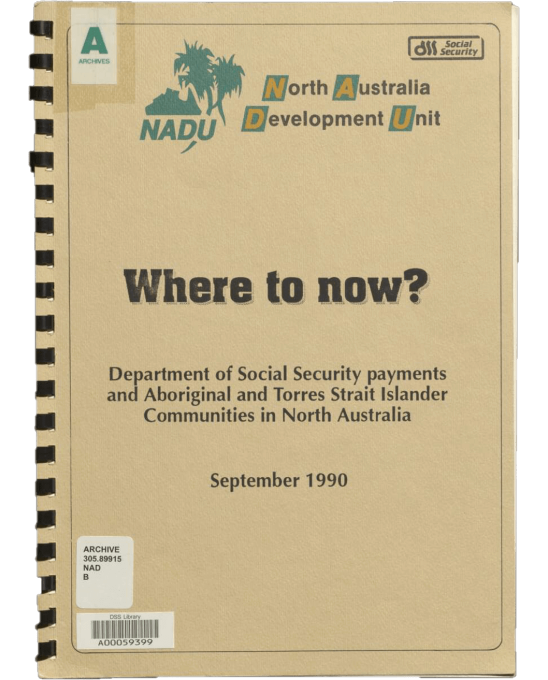
Report bases advice on Aboriginal people’s experiences
DSS asked residents of Aboriginal communities in northern Australia whether social security met their needs, what problems they had getting payments and if any changes to the system were needed.
… there is still no specific policy or strategic plan for the delivery of Department of Social Security services and programs to remote Aboriginal and Torres Strait Islander clients.
| Attachment | Size |
|---|---|
| where-to-now-report-and-literature-review.pdf | 20.76 MB |
| Attachment | Size |
|---|---|
| where-to-now-report-and-literature-review-excerpts.docx | 138.25 KB |
In 1990, the North Australia Development Unit (NADU) researched the social services needs of Aboriginal people living in remote communities. NADU was formed in 1988 and was part of the Department of Social Security (DSS).
Where to now? report, literature review and recommendations
This major research project was led by NADU project officers Yadhiagana / Wuthathi man Mick Adams, Waanyi woman Dell Burgen and Barry Smith.
They sought to analyse Aboriginal people’s views alongside existing research and reports. Their findings were as published as Where to now? across 3 documents: a report, a literature review and a collection of recommendations.
Report
To inform the Where to now? report, NADU interviewed people about DSS programs from the previous 10 years. They spoke to Aboriginal and Torres Strait Islander people from around 50 northern Australian communities.
The authors asked people what life in their community was like before they got government payments. They asked how the payments had affected their lives and whether the payments met their needs. They also sought feedback about how the government could improve their payments and services.
The report explained each payment that was available and the problems residents experienced getting the payment or getting the right amount.
Literature review
As well as interviewing people to find out views on social services, NADU also conducted a review of literature. They looked at letters, submissions, reviews, articles, journals and government publications about payments.
The review found that discrimination was still affecting Aboriginal and Torres Strait Islander people. It gave a history of the government’s past unfair practices and said that DSS staff were still being discriminatory at times.
Importantly, it found the government needed to work more closely with Aboriginal and Torres Strait Islander people to design successful programs. It said ‘white, urban-based national programs’ contributed to the destruction of Aboriginal and Torres Strait Islander cultures.
Summaries and proposals
To help the government look forward, NADU published a document of summaries and proposals, which included 32 recommendations.
NADU said the government should work alongside Aboriginal and Torres Strait Islander communities to create programs at a national level. This would ensure government programs respected customs around things such as ceremonies, marriage, age, initiation and widowhood. They said DSS should hire more Aboriginal and Torres Strait Islander people into senior positions to bring local knowledge and experience.
They also said DSS needed to do more to help Aboriginal and Torres Strait Islander people understand payments and services. They said people weren’t getting their full payments. They recommended more face-to-face options, including more Aboriginal Liaison Officers and Remote Visiting Teams. They also recommended expanding media campaigns aimed at Aboriginal and Torres Strait Islander communities, including the ‘Right story, right money’ campaign.
Their recommendations included looking into new types of payments that addressed specific issues in remote communities. For example, they suggested a payment other than Unemployment Benefit for people in places where there were no jobs.
These documents show DSS’s efforts to better address the needs of Aboriginal and Torres Strait Islander people in remote communities.
One of the authors of the Where to now? report was Michael (Mick) Adams, a descendent of the
Yadhiagana / Wuthathi people of Cape York Peninsula. Adams was one of the first Aboriginal Liaison Officers in DSS. He became a leader in Aboriginal health and education.
The second author is Waanyi woman Dell Burgen, who was a Senior Aboriginal and Islander Liaison Officer based in Mount Isa, Queensland. The lead author is Barry Smith, Senior Project Officer.
This version of the original report has been held in the Department of Social Services Library since 2004, when DSS acquired it from the Aboriginal and Torres Strait Islander Commission.
Permissions
Permissions to include these excerpts were granted by Dr Mick Adams, Dell Burgen, and Barry Smith.
Citation
Smith B, Adams M and Burgen D (June 1990) Payments and Aboriginal and Torres Strait Islander communities: a review of literature, North Australia Development Unit, Department of Social Security, Australian Government.
Smith B, Adams M and Burgen D (September 1990) Where to now? Department of Social Security payments and Aboriginal and Torres Strait Islander communities in north Australia, North Australia Development Unit, Department of Social Security, Australian Government.
